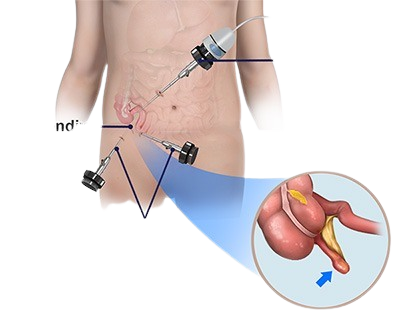Appendicetomy
What is appendicectomy?
Appendicectomy is the surgical removal of the appendix. It is the most commonly performed emergency surgery.
What is the appendix?
The appendix is a small finger-shaped organ attached to the caecum (first part of the colon). Its function is unknown. Blockage of the appendix because of infection, stool, foreign body or rarely a tumour can lead to appendicitis, the inflammation of the appendix.
What are the symptoms of appendicitis?
Appendicitis is characterised by pain, swelling of the stomach, loss of appetite, nausea and vomiting.
How is appendicitis diagnosed?
Appendicitis can be sometimes difficult to diagnose by symptoms as it can be common to other disorders as well.
Some of the tests that your doctor may order to diagnose appendicitis include an inspection of your abdomen for inflammation, blood and urine test and imaging studies such as CT scan and/or ultrasound.

What are the consequences of not treating appendicitis?
Left untreated, appendicitis can be life-threatening. It can perforate or burst, releasing infectious substances into the abdominal cavity.
What are the options for appendicitis treatment?
The standard treatment for appendicitis is the surgical removal of the appendix.
What are the alternative treatments for appendicitis?
Some studies indicate that antibiotics may help treat appendicitis.
How do I prepare for an appendectomy?
Before an appendectomy, you will be instructed not to eat or drink anything for 6 hours. Inform your doctor about the prescription drugs that you take on a regular basis. You will be advised on the ones you can take and those you should avoid. Antibiotics will be administered before the surgery.
How is an appendectomy performed?
Appendectomy is performed under general anaesthesia, by open or laparoscopic approach. Open surgery, called laparotomy, involves a single long incision in the lower right area of the abdomen. laparoscopic surgery uses several smaller incisions, a laparoscope and special surgical tools. The laparoscope, a thin long lighted tube with a camera attached, provides your surgeon with a clear magnified view of the surgical site on a large monitor.
By either method, your surgeon inserts a harmless gas into the abdominal cavity to expand the viewing area of the abdomen. Once the appendix is identified, it is tied off and removed. The area is then washed with sterile fluid to minimise the risk of infection. The incisions are then closed with absorbable sutures and waterproof dressings applied.
Sometimes a pus-filled mass called an appendiceal abscess, forms around a burst appendix. This may be addressed before or during appendectomy surgery by placing a tube in the abscess through the abdominal wall with the help of CT imaging. The drainage tube is left in place a period of time while antibiotics are given to treat the infection. At a later interval, when infection and inflammation are under control, surgery is performed to remove what remains of the burst appendix.
What can I expect after an appendectomy?
You will be shifted to the recovery room and monitored for the following appendicectomy. Usually you are able to go home the next day. Your doctor will prescribe pain medication to keep you comfortable and antibiotics if required. You are encouraged to move as early as possible which aids in your recovery.
What are the benefits of appendicectomy?
The removal of the appendix through appendicectomy ensures no further infection.
Laparoscopic or keyhole appendectomy is preferred over the open approach for the following reasons:
- Smaller incisions
- Reduced scarring
- Shorter hospital stay
- Fewer complications
- Lower risk for infection
- Faster recovery
However, in severe infections a laparotomy is sometimes required
Describe the stages of recovery and care.
Patients are able to be discharged usually the following day. If there is severe infection or the appendix had perforated prior to surgery this may be longer.
Most patients will have some discomfort at the wound sites which is generally gone within a week. During this time they are able to walk around and perform day to day activities.
Usually patients return to work or school after one week.
No heavy lifting is recommended for 4 weeks after the operation
What are the outcomes of appendicectomy?
Surgery occasionally reveals a normal appendix. In such cases, many surgeons will remove the healthy appendix to eliminate the future possibility of appendicitis. One of the advantages of laparoscopy is that the other organs within the abdominal cavity can be assessed to determine the cause for the symptoms. Occasionally, surgery reveals a different problem, which may also be corrected during surgery.
As with all surgeries, appendicectomy may be associated with certain complications such as infection, bleeding and damage to the neighbouring organs.
